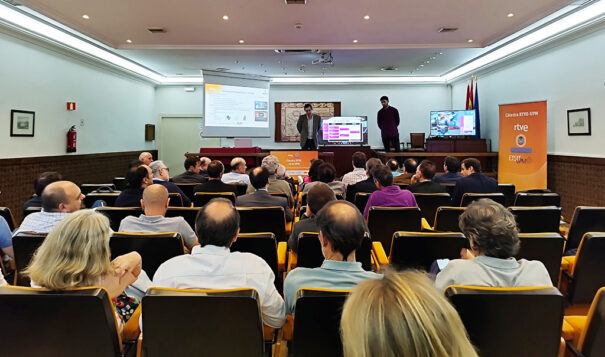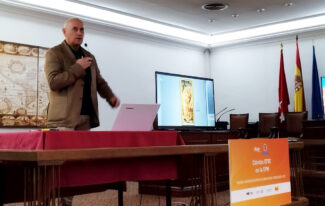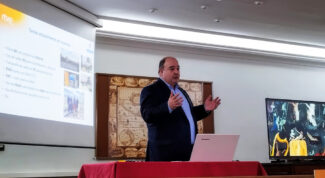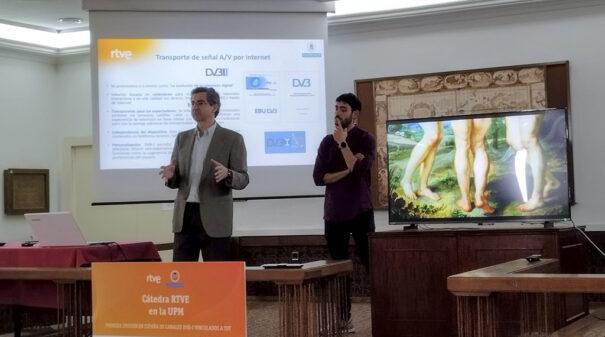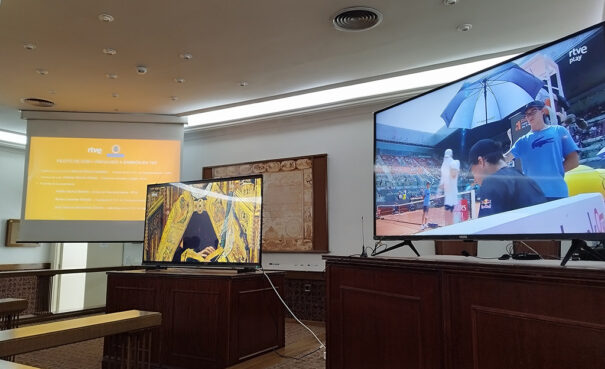La Cátedra RTVE-UPM abre nuevas puertas a la TDT con el primer piloto DVB-I
El equipo de la Cátedra RTVE-UPM, y varios representantes del equipo tecnológico de RTVE, han detallado las posibilidades y oportunidades que podría ofrecer la tecnología DVB-I a los espectadores españoles a través de una prueba piloto.
The Cátedra RTVE-UPM sigue ofreciendo experiencias innovadoras que buscan ofrecer nuevas posibilidades a la industria global. En un evento celebrado en el salón de grados de la ETSIT UPM de Madrid, se ha presentado la última de estas iniciativas: el primer piloto DVB-I (Digital Broadcasting – Interactive).
La cita, que ha contado con una importante representación de la industria broadcast española, ha contado con la introducción de Manuel Sierra Castañer, director de la ETSIT de Telecomunicación UPM, quien ha considerado “extremadamente importante” la presencia de los allí presentes puesto que sirve como ejemplo de “cómo la universidad puede colaborar con el sector empresarial, y cómo colaborar para un avance continuo de la tecnología para la sociedad”.
Inmediatamente después, Urbano García Alonso, director de innovación y digital de RTVE, ha destacado la apuesta decidida de la Corporación por la innovación: “Nuestra innovación es existencial. (…) No nos cabe otra opción que ser disruptivo”, ha remarcado, subrayando que este tipo de experiencias son fundamentales para “la visión transmedia y omnicanal futura de la televisión pública española”. Su compañero en RTVE, el director del área de emisión Adolfo Muñoz Berrón, ha completado sus palabras remarcando alguno de los hitos de la Cátedra RTVE-UPM (emisiones en UHD, uso de redes 5G para contribución, transporte de señal vía IP, uso de cloud) y ha expresado agradecimiento a las empresas que ha forman parte de la iniciativa: Cellnex, Dolby, Televés o Sapec, entre otras.
¿Por qué DVB-I?
El catedrático José Manuel Menéndez y el investigador Álvaro Llorente han iniciado la presentación de la experiencia piloto DVB-I repasando la historia de la transmisión broadcast a través de Internet; un proceso que se inició en 2004, se consolidó en 2015 con la llegada de players como Netflix o HBO y se encuentra actualmente en un momento especialmente efervescente. Algunas de las vías para acceder a Internet son las propias aplicaciones de las SmartTVs, HbbTV, Dongles y DVB-I.
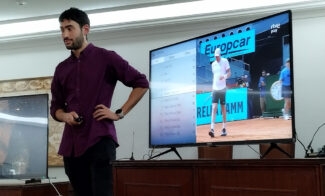 La tecnología DVB-I se apoya en varios estándares públicos para permitir difundir contenidos adicionales vía internet con los mecanismos más habituales: terrestre y satélite. Mediante el uso de una señal TDT y modificaciones en la señalización de la tabla NIT, el usuario podría recibir en su televisión compatible una serie de nuevos canales para complementar una emisión, sin necesidad de ampliar la capacidad del múltiplex: todo depende de una serie de indicadores que dirigen a una URL con todo tipo de contenido.
La tecnología DVB-I se apoya en varios estándares públicos para permitir difundir contenidos adicionales vía internet con los mecanismos más habituales: terrestre y satélite. Mediante el uso de una señal TDT y modificaciones en la señalización de la tabla NIT, el usuario podría recibir en su televisión compatible una serie de nuevos canales para complementar una emisión, sin necesidad de ampliar la capacidad del múltiplex: todo depende de una serie de indicadores que dirigen a una URL con todo tipo de contenido.
El funcionamiento del piloto
Para conducir la prueba, se utilizó un Github público que proporciona una parte de backend para editar las listas de servicio, así como soluciones frontend para probar la visualización en entornos HbbTV, dispositivos móviles y ordenadores. La señal recibida vía TDT en la UPM se ha modificado a través de este sistema, y ha sido emitido mediante un elemento radiante que ya incluye tanto el flujo TDT como el NIT modificado. Este, al ser sintonizado con varias televisiones cedidas por Vestel, han permitido ver esta señal de TDT enriquecida por las posibilidades de Internet en dos televisiones compatibles con DVB-I y otra con un receptor adicional.
Con relación a la emisión del contenido, la señal fue radiada desde la cabecera de TV de la E.T.S. de Ingenieros de Telecomunicación de la UPM, situada en la Ciudad Universitaria de Madrid, en el canal 44 de la UHF, asignado temporalmente a la Cátedra RTVE en la UPM por la Secretaría de Estado de Telecomunicaciones e Infraestructuras Digitales –SETID– para sus emisiones de pruebas. La configuración del múltiplex fue idéntica a la utilizada por el resto de las emisiones de TDT en España: 8 MHz de ancho de banda, modulación 64-QAM, 8K, IG 1/4, FEC 2/3, con una velocidad binaria efectiva de 19,91 Mbs. Hasta el 31 de mayo, cualquier persona que lo desee podrá contemplar in situ, en el laboratorio de la Cátedra RTVE en la UPM), la pantalla con la emisión de señal.
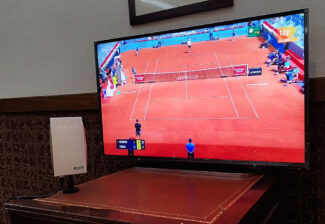 Las posibilidades futuras para este piloto, si bien todavía tiene retos que superar para su estandarización o versatilidad, podría ofrecer posibilidades para que los Broadcasters puedan incluir canales pop-up de forma transparente a los usuarios sin necesidad de resintonización, o canales que amplíen las limitaciones de la vía terrestre como elementos interactivos, gaming, realidad virtual o UHD.
Las posibilidades futuras para este piloto, si bien todavía tiene retos que superar para su estandarización o versatilidad, podría ofrecer posibilidades para que los Broadcasters puedan incluir canales pop-up de forma transparente a los usuarios sin necesidad de resintonización, o canales que amplíen las limitaciones de la vía terrestre como elementos interactivos, gaming, realidad virtual o UHD.
Did you like this article?
Subscribe to us RSS feed And you will not miss anything.



